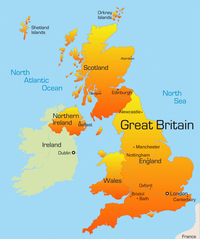Well, obviously, ONE THING they have in common is that they have all been subjected to BAAL, by way of the Temple ARCH being resurrected and glorified in their midst.
Now that you know so much about BERN, I want us to look at some things that might clarify why these three particular cities were selected.
Of course we know that these three locations are not the only places where they have erected the ARCH TO THE TEMPLE OF BAAL. They may not even be THE most important locations selected. However, they commonalities between these three locations makes it very clear that there is a significant tie and that these are very powerful spiritual centers. These were selected very specifically and the timing of each event was very carefully designed.
One thing that is present at the BERN location that is not at the others is the MOUNTAINS. The HIGH places. There is very strong spiritual significance to any HIGH place. We are learning that there is equal significance to the physical aspects of the mountains. They type of rocks that compose the mountain and type of water that is present play a huge role in their magick. Certainly the spiritual energy that is generated by the local population is another factor.
Everything is being purposefully orchestrated. We need to seek God and listen for his revelations regarding the type of warfare that is going on, and what we can do to counteract it. Things are escalating very rapidly in the spirit. Most people have NO CLUE about the evil forces that are amassing in opposition to them. They are busy entertaining themselves and will be caught totally unaware.
Take a look at the factors these three locations have in common. You will get a good idea of what these folks are up to. You may get some revelations that I missed. This warfare is being waged on so many fronts and in so many areas, it is hard to keep up. None of us can see the whole picture.
 BERN, Switzerland
BERN, Switzerland
Old Town City Square
Zytglogge the Clock Tower/Time/Astrology
Swiss Financial Market Supervisory Authority
BX SWISS Stock Exchange
Swiss National Bank
Totem on Display – Bear
Bern is the Capitol of its Canton (state) as well as the Federal Capitol of Switzerland.

Coat of arms of Bern
The coat of arms of Bern, along with the associated flag and heraldic colours, are used both by the Swiss city of Bern and by the canton of the same name. They were also used by the former district of Bern until its abolition in 2009.
The coat of arms of Bern is on a red field a yellow diagonal band charged with a black bear walking upwards toward the hoist. The heraldic blazon reads: Gules, on a bend or, a bear passant sable, langued, armed and vilené of the field. The flag of Bern is square and depicts the coat of arms. The heraldic colours of Bern are red and black
As Justinger’s chronicle reveals, Bern’s original coat of arms was an upright black bear on a white shield (which is, incidentally, the coat of arms of Berlin). In the 13th century, the coat of arms changed to the one in use today. The modern coat of arms is already recognisable in Alsatian mercenary songs of 1375 reported by Justinger. The change, according to the chroniclers, was linked to the Battle of the Schosshalde in 1289 against the troops of Duke Rudolf II of Austria, son of Emperor Rudolf II von Habsburg. According to Justinger, a Bernese salvaged a part of the ensign as the fortunes of war turned against Bern, and Tschudi recounts:
- Until then, those of Bern carried the bear in a white field, but the field turned red that day, as the banner was drenched in blood.[2]
The chronicler Stumpf then adds that the diagonal band changed from silver to gold to celebrate the eventual Bernese victory over the House of Habsburg.
_____________
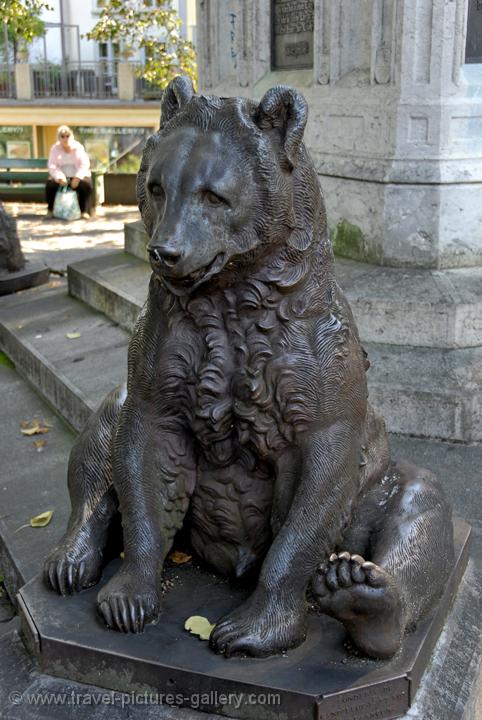
THE CITY OF BEARS
But this story is questionable. Others say that the name of Bern comes not from Berchtold’s hunting prowess but from an old Celtic name for the settlement that was changed over time; Brenodor.
Nevertheless, Bern’s association with bears has held firm ever since. During the medieval ages, Bernese warriors were often depicted in the form of ferocious bears. In 1513, a writer by the name of Valerius Anshelm tells of how Bernese soldiers captured a live bear after the Battle of Novara and brought it back to the city. The bear was kept alive in the city’s moat. This was the city’s first makeshift bear pit.

The Zytglogge
First it was a fortified guard tower, then a prison, a lookout and fire observation tower, and finally a clock tower. Over the centuries, this landmark has fulfilled different functions for the city of Bern but has always played a key role.
As Bern continued to grow and expand its city limits, the former guard tower gradually found itself closer and closer to the city center. After the devastating fire of 1405, the structure was rebuilt and given a new identity.
Now known as the Zytglogge (Clock Tower), it began telling time for the inhabitants of Bern. As the official timekeeper, its location could not be more central and from then on, the locals listened for it to strike the hours.
The tower was also an authoritative building for other matters in the capital city. For example, official travel times were measured from the Clock Tower and marked on stones along the cantonal roads. The ancient length measurements of cubit and fathom – which are still marked today in the tower entrance as meter and double meter – served as the reference length and for official checks.
Besides these unique arcades, Bern’s historical townscape, dating back to 1191, is characterized by the Clock Tower (Zytglogge), the Prison Tower (Käfigturm), the sculptural fountains from the Renaissance, the Cathedral (Münster), and the well-kept sandstone facades. Visitors can discover bars, cultural venues, and specialty shops in countless converted cellars.
 |
BX SwissFounded – 1880 BX Swiss (formerly Berne eXchange, abbreviated: BX) is a Swiss stock exchange operated by BX Swiss AG (formerly Berner Börsenverein). It has its main office in Zurich and is subject to the supervision by the Swiss Financial Market Supervisory Authority (FINMA). |
 |
Swiss Financial Market Supervisory AuthorityHeadquarters – The Swiss Financial Market Supervisory Authority (FINMA) is the Swiss government body responsible for financial regulation. This includes the supervision of banks, insurance companies, stock exchanges and securities dealers, as well as other financial intermediaries in Switzerland. The FINMA is an independent institution with its own legal personality based in Bern.[2] It is institutionally, functionally and financially independent from the central federal administration and the Federal Department of Finance and reports directly to the Swiss parliament. |
|
|
THE SWISS BANKSwiss banks are known for their banking secrecy and security. Pictured: the Mont Cervin Palace in Zermatt. A hub of tourism, many private banks service the city and maintain underground bunkers and storage facilities for gold at the foothills of the Swiss Alps |
NEW YORK CITY, New York, USA
TIMES SQUARE
TIME/Paramount Building Clock Tower
New York Stock Exchange
Federal Reserve Bank of New York
Totem on Display – BULL
New York City is the Capitol of New York State but it also was the first capital of the United States after the United States.
- New York City was the first capital of the United States after the Constitution was ratified in 1788. On April 30, 1789, George Washington was inaugurated as the nation’s first president at Federal Hall, located on Wall Street.
Seal of New York City

The two supporters represent the unity between Native Americans and colonists: dexter, a sailor colonist holds a plummet—a navigational tool—in his right hand, while over his right shoulder is a cross-staff; sinister, a Lenape native to Manhattan rests his left hand upon a bow.
Upon the arms / shield, the four windmill sails recall the city’s Dutch history as New Amsterdam and the beavers and flourbarrels signify the city’s earliest trade goods (see History of New York City). The flour barrels and windmills represent the tremendous wealth generated by New York City from the Bolting Act of 1674.[2] The act gave the city an exclusive monopoly to mill and export flour. The shield and supporters rest upon a horizontal laurel branch.
The crest over the seal is the bald eagle, added in 1784, after the American Revolution. Prior to this change, a crown had been located in this space, representing the authority of the monarchy during the British colonial period. The eagle rests upon a hemisphere. At the bottom is the date, 1625, when New Amsterdam, the colonial Dutch settlement which would later become New York, was designated the capital of the province of New Netherland. The first Dutch settlers actually arrived in the region in 1624, and the town of New Amsterdam was incorporated in 1653.[3] The English came in 1664, and the Dutch Governor Peter Stuyvesant surrendered, signing the English documents on September 8, 1664, whereupon it was renamed New York. The 300th Anniversary of New York City was celebrated with the World’s Fair in 1964 in Flushing Meadows, within the borough of Queens, where religious freedom was first recognized with the Flushing Remonstrance in 1657. A laurel wreath encircles the seal.
The city clerk is the custodian of the City Seal.
Changes to the seal
Unofficial flag featuring the old seal, replaced by the 1915 flag
| Year of change | Description of change(s) made |
|---|---|
| 1784 | Bald eagle was added to replace a crown.[3] |
| 1915 | Complete overhaul of the seal by a blue-ribbon committee appointed by the City Art Commission.[4] |
| 1977 | Changed the date from 1664 to 1625.[3] |
Prior to 1915, New York City’s contemporary seal lacked an official standard, and was often subject to variations featuring a number of different arrangements of the eagle, and the two figures at either side of the coat of arms. For this reason the New York Arts Commission formed a blue-ribbon committee to create a new seal and flag.[4] This committee worked with the New-York Historical Society to study imagery and seals going back to the earliest days of New Amsterdam.[5] Incorporating that historical iconography, the committee developed a new seal and flag design, which was submitted to the board of aldermen on March 16, 1915. The board approved the recommendations seven days later, and the Arts Commission contracted renowned American sculptor Paul Manship to develop a physical version of the revised seal which could be duplicated across city departments as an official symbol.
An alternate version of the seal, without the Latin legend, is found on the city flag.[8]
The Story Behind The Legendary Charging Bull
The creator of the Charging Bull, Arturo Di Modica, is an Italian-American artist born in Sicily in 1941. Di Modica started sculpting in his teen years and quickly began to get recognized for it. By the age of 19, he moved to Florence. Within 12 years he became known throughout Italy for his sculptures. In the early 70’s, Di Modica moved to New York and opened a studio on Grand Street.
Di Modica created the Charging Bull using $360,000 of his own money. The sculpture weighs over 7,000 pounds and is 11 feet tall. You can find the Bull in Bowling Green near Battery Park and Wall Street. However, this was not the original location of the Bull. On December 15th, 1989, Di Modica set out during the early hours of the morning to place the statue. With the help of the Bedi Makky Art Foundry, they found a home for the Bull right outside of the New York Stock Exchange on Broad Street.

The Stock Market Crash of 1987 inspired the artist’s choice of animal. For Di Modica, the Bull was a symbol of the ”strength and power of the American people.”
|
|
|
|
|
|
 Paramount Building Clock Tower, Times Square
Paramount Building Clock Tower, Times Square
The Paramount Building has retained a regal presence in Times Square since it was completed in 1927, despite the arrival of many new skyscrapers over the years. Some if its staying power could be in part to the globe and clocktower that crown the 33-story building, designed by architects Rapp & Rapp in the classic setback style that emerged as a result of the 1916 New York City Zoning Ordinance.
According to The Landmarks of New York, the Paramount Building was an architectural “symbol of the company’s role in the motion picture industry.” Theatrical floodlights once lit up each of the building’s setbacks. The globe on top, according to The Landmarks of New York“was placed atop the clocktower to advertise the worldwide activities of Paramount.” The clock face shows five-pointed stars, the Paramount symbol, instead of the hour numbers. A film of the construction, heralding today’s common practice of using time lapse photography and video to document new construction, was made in the 1920s.
One Times Square
Constructed in 1904 as the headquarters for the New York Times, it was the tallest building in the city when measured from basement level to roof deck. One Times Square’s completion coincided with the opening of the city’s first subway line in 1904 and was instrumental in the development of its surroundings into a thriving commercial area. In a brilliant publicity ploy, the paper’s owner Adolph Ochs volunteered to hold the city’s New Year’s Eve celebration for the building’s opening year.
Inspired by the downtown Western Union Telegraph building’s clock tower, which dropped an iron ball at noon each day, Palmer hired a young Russian immigrant, Jacob Starr, to create a 700-pound ball made of iron and wood. The Times Square Ball was made that year, illuminated with one hundred 25-watt lightbulbs and ceremoniously lowered at midnight. The event was a massive success, and for most of the remainder of the 20th century, Starr, and later the sign-making company he founded, Artkraft Strauss, continued to be responsible for the yearly ball dropping ceremony as well as much of the design of the massive, luminous signage that has become indelibly associated with Times Square.
TIMES SQUARE

Times Square is a major commercial intersection, tourist destination, entertainment center and neighborhood in the Midtown Manhattan section of New York City at the junction of Broadway and Seventh Avenue. It stretches from West 42nd to West 47th Streets.[1] Brightly adorned with billboards and advertisements, Times Square is sometimes referred to as “The Crossroads of the World”,[2] “The Center of the Universe”,[3] “the heart of The Great White Way“,[4][5][6] and “the heart of the world”.[7] One of the world’s busiest pedestrian areas,[8] it is also the hub of the Broadway Theater District[9] and a major center of the world’s entertainment industry.[10] Times Square is one of the world’s most visited tourist attractions, drawing an estimated 50 million visitors annually.[11] Approximately 330,000 people pass through Times Square daily,[12] many of them tourists,[13] while over 460,000 pedestrians walk through Times Square on its busiest days.[7]
Formerly known as Longacre Square, Times Square was renamed in 1904 after The New York Times moved its headquarters to the then newly erected Times Building – now One Times Square – the site of the annual New Year’s Eve ball drop which began on December 31, 1907, and continues today, attracting over a million visitors to Times Square every year.[14][15]
Times Square functions as a town square, but is not geometrically a square; it is closer in shape to a bowtie, with two triangles emanating roughly north and south from 45th Street,[16] where Seventh Avenue intersects Broadway. Broadway runs diagonally, crossing through the horizontal and vertical street grid of Manhattan laid down by the Commissioners’ Plan of 1811, and that intersection creates the “bowtie” shape of Times Square.[17]
The southern triangle of Times Square has no specific name,[18] but the northern triangle is called Father Duffy Square. It was dedicated in 1937 to Chaplain Francis P. Duffy of New York City’s U.S. 69th Infantry Regiment and is the site of a memorial to him, along with a statue of George M. Cohan,[19] as well as the TKTS reduced-price ticket booth run by the Theatre Development Fund. Since 2008, the booth has been backed by a red, sloped, triangular set of bleacher-like stairs, which is used by people to sit, talk, eat, and take photographs.
The New York Stock Exchange
(NYSE, nicknamed “The Big Board“)[5] is an American stock exchange located at 11 Wall Street, Lower Manhattan, New York City, New York. It is by far[6][7] the world’s largest stock exchange by market capitalization of its listed companies at US$30.1 trillion as of February 2018.[8] The average daily trading value was approximately US$169 billion in 2013. The NYSE trading floor is located at 11 Wall Street and is composed of 21 rooms used for the facilitation of trading. A fifth trading room, located at 30 Broad Street, was closed in February 2007. The main building and the 11 Wall Street building were designated National Historic Landmarks in 1978.
The NYSE is owned by Intercontinental Exchange, an American holding company that it also lists (NYSE: ICE). Previously, it was part of NYSE Euronext (NYX), which was formed by the NYSE’s 2007 merger with Euronext.
Federal Reserve Bank of New York
|
|
The Federal Reserve Bank of New York is one of the 12 Federal Reserve Banks of the United States. It is located at 33 Liberty Street, New York, New York. It is responsible for the Second District of the Federal Reserve System, which encompasses New York State, the 12 northern counties of New Jersey, Fairfield County in Connecticut, Puerto Rico, and the U.S. Virgin Islands. Working within the Federal Reserve System, the Federal Reserve Bank of New York implements monetary policy, supervises and regulates financial institutions[1] and helps maintain the nation’s payment systems.[2]
Among the other regional banks, the New York Fed and its president are considered first among equals.[3] Its current president is John C. Williams. It is by far the largest (by assets), most active (by volume) and most influential of the 12 regional Federal Reserve Banks.
EstablishedMay 18, 1914
HeadquartersFederal Reserve Bank of New York Building
New York, New York, USA

LONDON, England
TRAFALGA SQUARE
BIG BEN/TIME/CLOCK/TOWER
New York Stock Exchange
Federal Reserve Bank
Totem on Display – Lion
London is the Capitol of England and The United Kingdom
———–
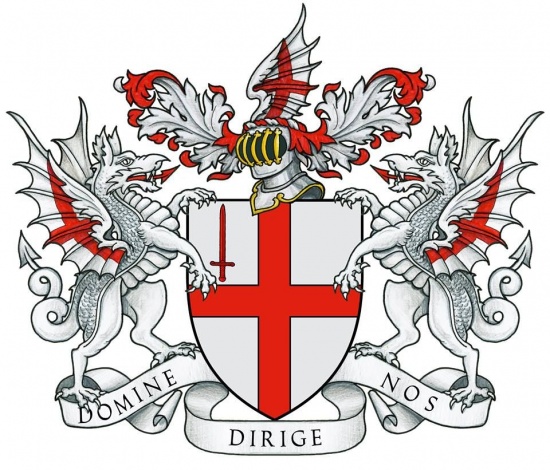
Coat of arms of the City of London
The coat of arms of the City of London is the official coat of arms of the City of London, which is one of a number of cities and boroughs in Greater London.
Description and blazon
The Corporation of the City of London has a full achievement of armorial bearings consisting of a shield on which the arms are displayed, a crest displayed on a helmet above the shield, supporters on either side and a motto displayed on a scroll beneath the arms.[1][2][3]
The blazon of the arms is as follows:[1][2][3]
Arms: Argent a cross gules, in the first quarter a sword in pale point upwards of the last.
Crest: On a wreath argent and gules a dragon’s sinister wing argent charged on the underside with a cross throughout gules.
Supporters: On either side a dragon argent charged on the undersides of the wings with a cross throughout gules.
The Latin motto of the City is Domine dirige nos, which translates as “Lord, direct (guide) us”. It appears to have been adopted in the 17th century, as the earliest record of it is in 1633.[3][4]
A banner of the arms (the design on the shield) is flown as a flag of the City.
|
|
|
|
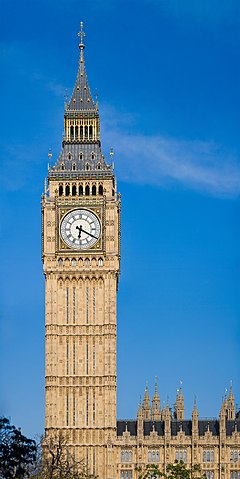
BIG BEN
Big Ben is the nickname for the Great Bell of the clock at the north end of the Palace of Westminster in London[1] and is usually extended to refer to both the clock and the clock tower.[2][3] The official name of the tower in which Big Ben is located was originally the Clock Tower, but it was renamed Elizabeth Tower in 2012 to mark the Diamond Jubilee of Elizabeth II.
The tower was designed by Augustus Pugin in a neo-Gothic style. When completed in 1859, its clock was the largest and most accurate four-faced striking and chiming clock in the world.[4] The tower stands 315 feet (96 m) tall, and the climb from ground level to the belfry is 334 steps. Its base is square, measuring 39 feet (12 m) on each side. Dials of the clock are 23 feet (7.0 m) in diameter. On 31 May 2009, celebrations were held to mark the tower’s 150th anniversary.[5]
Big Ben is the largest of the tower’s five bells and weighs 13.5 long tons (13.7 tonnes; 15.1 short tons).[1] It was the largest bell in the United Kingdom for 23 years. The origin of the bell’s nickname is open to question; it may be named after Sir Benjamin Hall, who oversaw its installation, or heavyweight boxing champion Benjamin Caunt. Four quarter bells chime at 15, 30 and 45 minutes past the hour and just before Big Ben tolls on the hour. The clock uses its original Victorian mechanism, but an electric motor can be used as a backup.
The tower is a British cultural icon recognised all over the world. It is one of the most prominent symbols of the United Kingdom and parliamentary democracy,[6] and it is often used in the establishing shot of films set in London.[7] The clock tower has been part of a Grade I listed building since 1970 and a UNESCO World Heritage Site since 1987.
TRAFALGAR SQUARE

Location City of Westminster, London, England
Completion c. 1840
Designer Sir Charles Barry
The site of Trafalgar Square had been a significant landmark since the 13th century and originally contained the King’s Mews. After George IV moved the mews to Buckingham Palace, the area was redeveloped by John Nash, but progress was slow after his death, and the square did not open until 1844. The 169-foot (52 m) Nelson’s Column at its centre is guarded by four lion statues. A number of commemorative statues and sculptures occupy the square, but the Fourth Plinth, left empty since 1840, has been host to contemporary art since 1999.
The square has been used for community gatherings and political demonstrations, including Bloody Sunday in 1887, the culmination of the first Aldermaston March, anti-war protests, and campaigns against climate change. A Christmas tree has been donated to the square by Norway since 1947 and is erected for twelve days before and after Christmas Day. The square is a centre of annual celebrations on New Year’s Eve. It was well known for its feral pigeons until their removals in the early 21st century.

The LONDON STOCK EXCHANGE
London Stock Exchange is a stock exchange located in the City of London, England. As of April 2018, London Stock Exchange had a market capitalisation of US$4.59 trillion. It was founded in 1571, making it one of the oldest exchanges in the world.[2] Its current premises are situated in Paternoster Square close to St Paul’s Cathedral in the City of London. It is part of London Stock Exchange Group (LSEG).
London Stock Exchange is one of the world’s oldest stock exchanges and can trace its history back to 1571. London Stock Exchange Group was created in October 2007 when London Stock Exchange merged with Milan Stock Exchange, Borsa Italiana.
Bank of England
 |
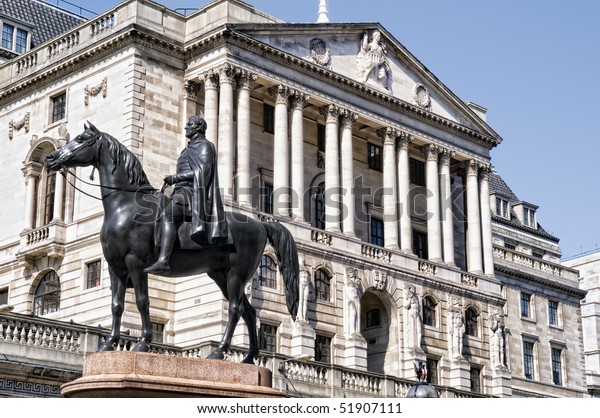 |
The Bank of England is the central bank of the United Kingdom and the model on which most modern central banks have been based. Established in 1694 to act as the English Government‘s banker, and still one of the bankers for the Government of the United Kingdom, it is the world’s eighth-oldest bank. It was privately owned by stockholders from its foundation in 1694 until it was nationalised in 1946.[2][3]
The Bank became an independent public organisation in 1998, wholly owned by the Treasury Solicitor on behalf of the government,[4] but with independence in setting monetary policy.[5][6][7][8]
The Bank is one of eight banks authorised to issue banknotes in the United Kingdom, has a monopoly on the issue of banknotes in England and Wales and regulates the issue of banknotes by commercial banks in Scotland and Northern Ireland.[9]
The Bank’s Monetary Policy Committee has a devolved responsibility for managing monetary policy. The Treasury has reserve powers to give orders to the committee “if they are required in the public interest and by extreme economic circumstances”, but such orders must be endorsed by Parliament within 28 days.[10] The Bank’s Financial Policy Committee held its first meeting in June 2011 as a macroprudential regulator to oversee regulation of the UK’s financial sector.
The Bank’s headquarters have been in London’s main financial district, the City of London, on Threadneedle Street, since 1734. It is sometimes known as The Old Lady of Threadneedle Street, a name taken from a satirical cartoon by James Gillray in 1797.[11] The road junction outside is known as Bank junction.
As a regulator and central bank, the Bank of England has not offered consumer banking services for many years, but it still does manage some public-facing services such as exchanging superseded bank notes.[12] Until 2016, the bank provided personal banking services as a privilege for employees.[13]
Sometimes you find answers in unexpected places. I found the most succinct description I’ve ever seen of how England, Great Britain and the United Kingdom relate to each other in a library newsletter about travel guidebooks:
- London is the capital of England.
- England is a country.
- Britain is an area that consists of England and the country of Wales.
- Great Britain is the name of the island that is home to the countries of England, Wales, and Scotland.
- The United Kingdom (UK) is a country that is a union of the countries on the island of Great Britain, along with the country of Northern Ireland (which shares the island of Ireland with the Republic of Ireland.)
- The Republic of Ireland is a separate country that is not part of the UK.
- London is also the capital of the UK.
Guidebooks will often include various parts of this geography, with the most common subdivisions being London, England, and Great Britain. Travelers should be aware that while all residents of the UK are British subjects, residents of Wales, Scotland, and Northern Ireland will prefer to be referred to as Welsh, Scottish, and Irish, respectively, rather than British.
Description from Reviews: Library Journal; Travel, the London Olympics and Beyond, February 28, 2012
Written by Janet on July 20, 2012
OK, My thought on this section! If you reviewed my series titled “IT’s ABOUT TIME”, you know that controlling, manipulating and traveling through time is what they are all about. They are also about preparing the world to accept the ANTI-CHRIST/Apollo/Abbadon/BAAL. They are using magick to blind the minds of the human race and control them. These cities are very strategic spiritually. They are gateways, they are places of authority and headship, they are cities where spirits have been at work for a very long time. We need to become more aware with what is happening around us. Deception is rampant.
They are using geographical, magnetic, electric, meteorological, vibrational and astronomical powers against us. Human beings are made up of water and just like the crystals that receive radio and television signals, our bodies are receptors. They are transmitting at us all the time. Rocks, water, wind, they all contain energy. They are focusing those energies against us. I am telling you, the only way that you will come out of this well is to get as close to GOD as you can. We cannot stand against these forces, but all the forces that the enemy can muster cannot stand against the Creator/YaHovah! Hallelujah! HE IS MIGHTY TO SAVE!


